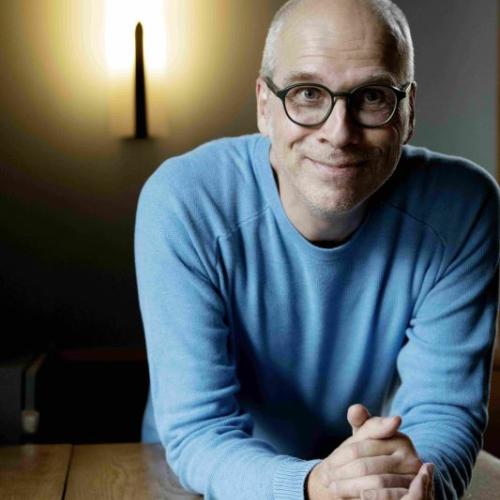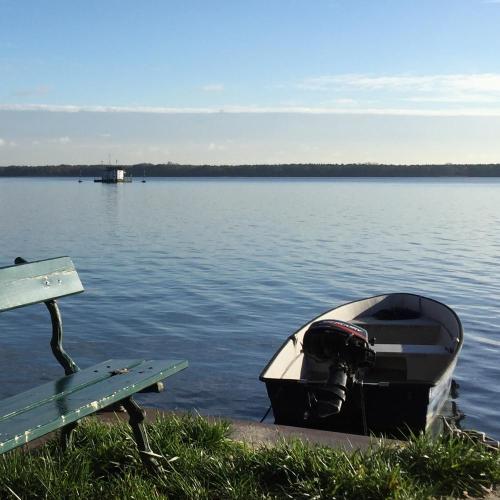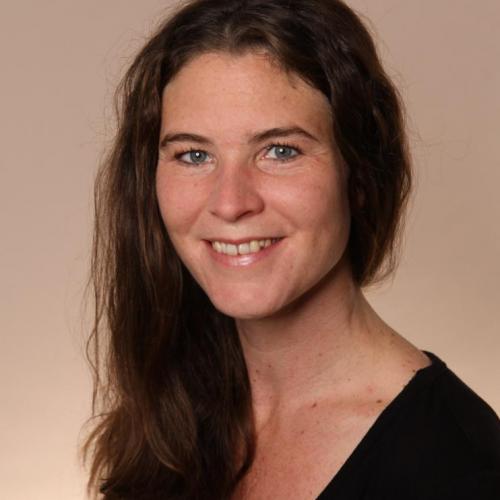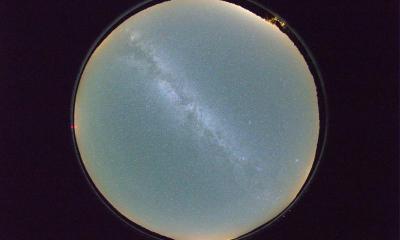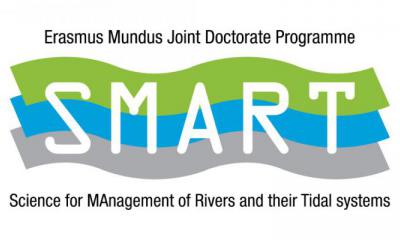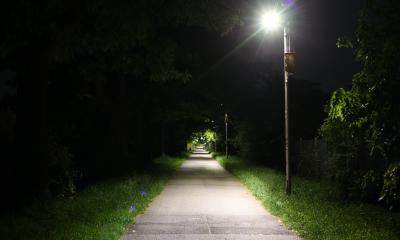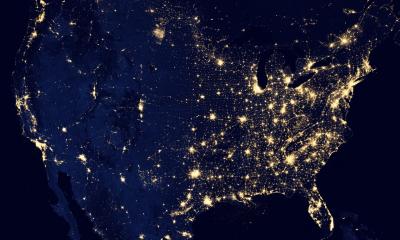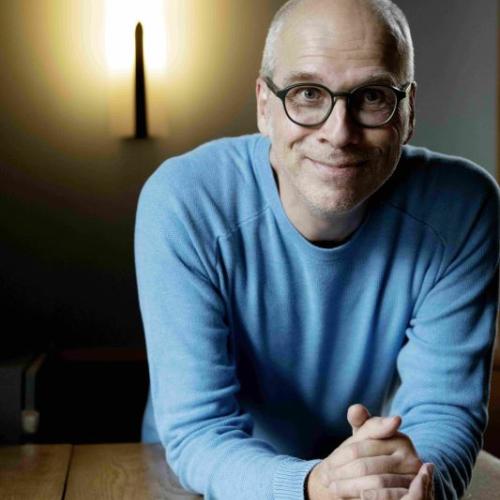
Light Pollution and Ecophysiology

Group profile
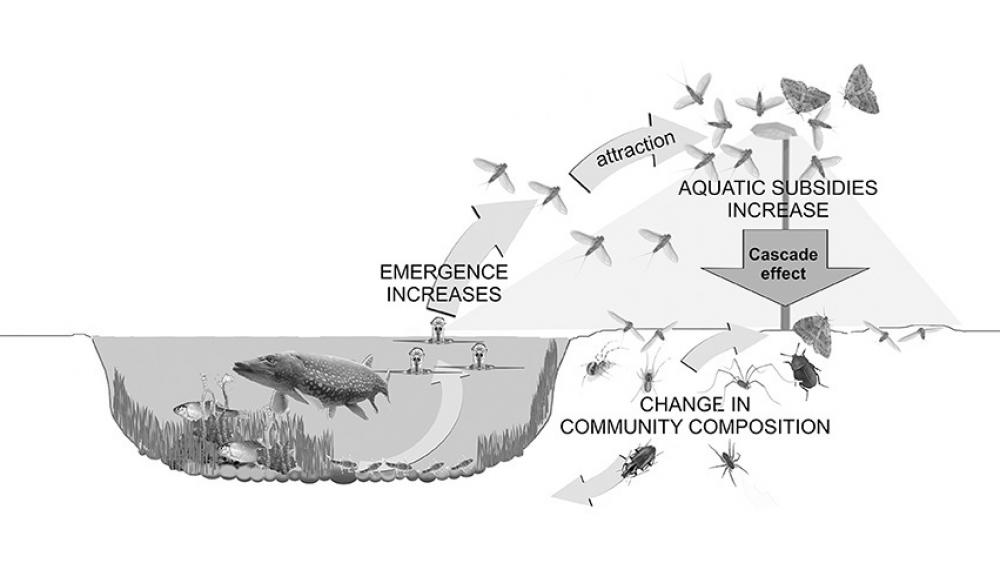
Conceptual figure depicting how artificial light at night (ALAN) increases the flux of aquatic insects into the riparian area through an increase in emergence under lamps and increased attraction of aquatic insects to light. The community of riparian ground-dwelling predators and scavengers is altered in the lit area and some night-active riparian spiders extend their activity into the day. Both likely are the result of the large increase in input of freshwater-derived prey. | Image: Manfrin et al. Front. Environ. Sci. 5:61, doi: 10.3389/fenvs.2017.00061
Artificial light at night is widespread and increasing at a rate of around 2-6% a year worldwide. Because it has been introduced in places, times and at intensities at which it does not naturally occur, artificial light has becoming a potential threat to biodiversity. Despite the ubiquity of artificial light, its effects on ecosystems, especially freshwaters, have not yet been extensively studied. Our research thus largely focuses on biological impacts of artificial light on a wide range of biological processes, from gene expression to land-water-interactions and ecosystem functions. At the moment we are running large-scale field experiments at two different ecosystems: we assess the impact of streetlights on grassland-ditch systems in the Dark Sky reserve Westhavelland (BfN/BMUB) and the impact of simulated skyglow at LakeLab in Lake Stechlin (SAW ILES). Another important research domain is getting a comprehensive quantitative understanding of the amount of light in the nocturnal (SAW ILES) and the diurnal (IGB-Frontiers, SAW CONNECT) environment in a combination of satellite and ground based measurements for monitoring of and with light (remote sensing). In addition, our aim is to directly transfer knowledge into society, e.g. in a combination of transdisciplinary communication and citizen science involvement (EU Horizon-2020 STARS4ALL, BfN/BMUB).
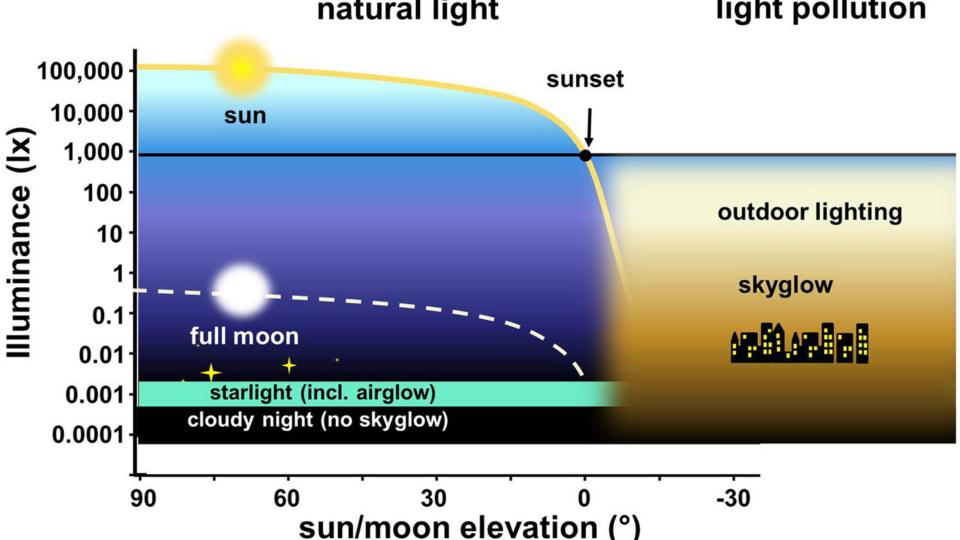
Ranges of exposure that animals experience and respond to with natural variation in light and light intensities observed with ALAN (here using human-centric metric lux). Illuminance during day, twilight, and night as a function of elevation angle of sun and moon; yellow solid line—sun illuminance on clear day, gray dashed line—moonlight full moon. (Figure from Hölker et al. Front. Ecol. Evol. 9:767177 doi: 10.3389/fevo.2021.767177)
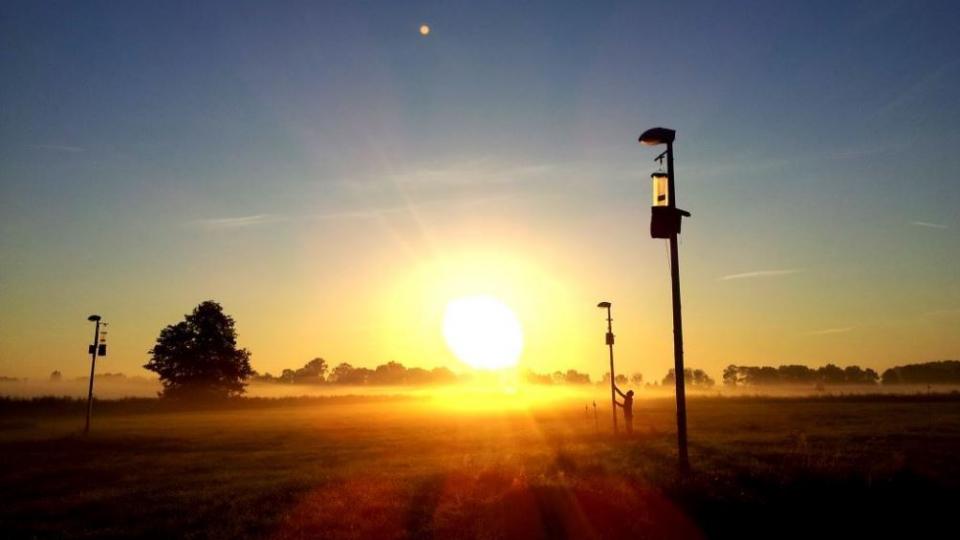
Experimental field site in Westhavelland Nature Park. | Photo: Maja Grubisic / IGB
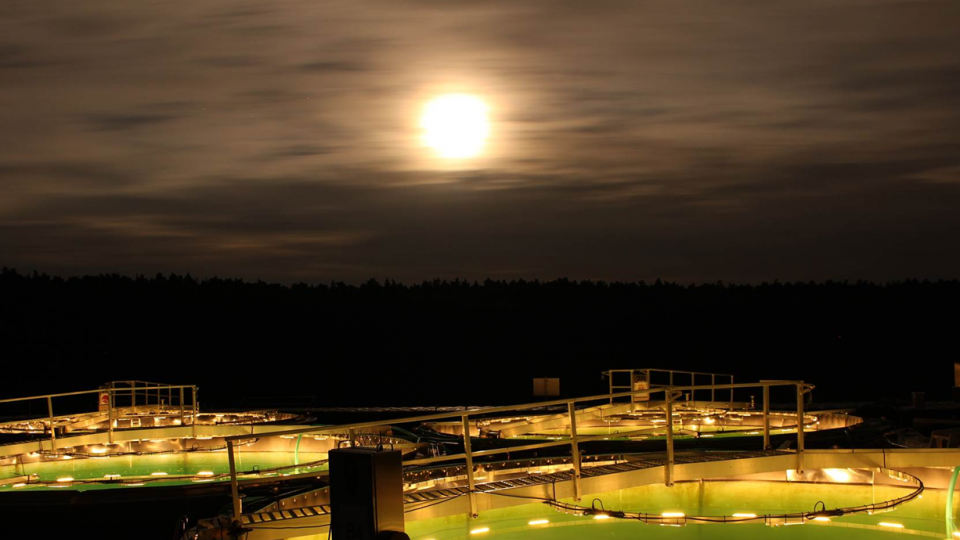
Illuminated enclosures of the IGB LakeLab. | Photo: A. Jechow / IGB
The novel luminaire developed with Selux and TU Berlin in project AuBe during an insect sampling at the field site in Westhavelland | Foto: G. Kalinkat / IGB
Group members
Alumni
Scientists
- Dr. Chris Kyba
- Dr. Ulrike Scharfenberger
- Dr. Alessandro Manfrin
- Dr. Roy van Grunsven
- Dr. Elizabeth Perkin
- Dr. Annette Krop-Benesch
- Dr. Gregorio López Moreira
- Dr. Antje Kerkow
Students
- Carsten Weißenborn (Master FU Berlin)
- Nadine Weiß (Diplom FU Berlin)
- Nina-Sophie Weiß (Master FU Berlin)
- Judith Kühne (Master FU Berlin)
- Simon Hansul (Master FU Berlin)
- Olivia Weis (Master FU Berlin)
- Mona Storms (Master FU Berlin)
- Michele Bonazzi (Master Universität Trento)
- Hannes Schäricke (Bachelor Hochschule Zittau/Görlitz)
- Alina Filipp (Bachelor HU Berlin)
- Anna Slopianka (Bachelor HU Berlin)
- Pauline Staroske (Bachelor FU Berlin)
Publications
Publications
2025
July 2025
Alfredo Schiavon; Claudio Comoglio; Alessandro Candiotto; Michele Spairani; Franz Hölker; Johan Watz; Daniel Nyqvist
Movement Pattern and Habitat Use of the Endangered Brook Barbel (Barbus caninus) in a Mediterranean Stream
Ecology of Freshwater Fish. - 34(2025)4, Art. e70017
June 2025
Gregor Kalinkat; Andreas Jechow; Sibylle Schroer; Franz Hölker
Nocturnal pandas: conservation umbrellas protecting nocturnal biodiversity
Trends in Ecology and Evolution. - 40(2025)8, 736-739
June 2025
Sophia Schumann; Velizara Stoilova; Enrico Bortoletto; Elisabetta Piva; Sara Pacchini; Gloria Mozzi; Andreas Jechow; Andrea Marion; Daniela Bertotto; Ann Erlandson; Franz Hölker; Larry Greenberg; Gianfranco Santovito
Impact of artificial light at night (ALAN) on cardiac function and acute oxidative stress physiology in migratory brown trout smolts
Environmental Pollution. - 381(2025), Art. 126593
May 2025
Nedim Tüzün; Luc De Meester; Franz Hölker
Eco-evolutionary feedbacks under artificial light at night
iScience. - 28(2025)6, Art. 112616
March 2025
James Adam Campbell; Samuel Joseph Shry; Petter Lundberg; Olle Calles; Franz Hölker
A population Monte Carlo model for underwater acoustic telemetry positioning in reflective environments
Methods in Ecology and Evolution. - 16(2025)4, 775-785
February 2025
Manuel Dietenberger; Andreas Jechow; Manuela Sann; Franz Hölker
Shedding light on dark taxa: exploring a cryptic diversity of parasitoid wasps affected by artificial light at night
Scientific Reports. - 15(2025), Art. 6237
February 2025
S. E. Kimmig; F. Hölker; S. Schroer; A. Kassiem; S. Kiefer
Come to the dark side – citizen science in nighttime ecology
BMC Ecology and Evolution. - 25(2025), Art. 15
February 2025
A. Manfrin; F. Hölker; S. Teurlincx; V. Baranov; R. H. A. van Grunsven; M. Bundschuh; M. T. Monaghan
Artificial light at night reduces emergence and attracts flying adults of aquatic Diptera
Aquatic Sciences. - 87(2025), Art. 38
January 2025
Megha Khanduri; Franz Hölker; Ruchika Sah; Syed Ainul Hussain; Ruchi Badola; Ulrika Candolin
January 2025
Alfredo Schiavon; Claudio Comoglio; Alessandro Candiotto; Michele Spairani; Franz Hölker; Johan Watz; Daniel Nyqvist
Individual movement behaviour and habitat use of a small-sized cypriniform (Telestes muticellus) in a mountain stream
Environmental Biology of Fishes. - 108(2025), S. 241–258
2024
October 2024
Alfredo Schiavon; Claudio Comoglio; Alessandro Candiotto; Michele Spairani; Franz Hölker; Fabio Tarena; Johan Watz; Daniel Nyqvist
Navigating the drought: upstream migration of a small-sized Cypriniformes (Telestes muticellus) in response to drying in a partially intermittent mountain stream
Knowledge & Management of Aquatic Ecosystems. - 425(2026), 6
October 2024
Jacqueline Degen; Mona Storms; Chengfa Benjamin Lee; Andreas Jechow; Anna Lisa Stöckl; Franz Hölker; Aryan Jakhar; Thomas Walter; Stefan Walter; Oliver Mitesser; Thomas Hovestadt; Tobias Degen
Shedding light with harmonic radar: Unveiling the hidden impacts of streetlights on moth flight behavior
Proceedings of the National Academy of Sciences of the United States of America. - 121(2024)42, Art. e2401215121
October 2024
Andreas Jechow; Jan Bumberger; Bert Palm; Paul Remmler; Günter Schreck; Igor Ogashawara; Christine Kiel; Katrin Kohnert; Hans-Peter Grossart; Gabriel A. Singer; Jens C. Nejstgaard; Sabine Wollrab; Stella A. Berger; Franz Hölker
September 2024
Henry H. Hansen; Claudio Comoglio; Jelger Elings; Philip Ericsson; Peter Goethals; Marie-Pierre Gosselin; Franz Hölker; Christos Katopodis; Paul Kemp; Lovisa Lind; Rachel Mawer; Gloria Mozzi; John M. Nestler; John Piccolo; Johannes Radinger; Matthias Schneider; Velizara Stoilova; Bernhard Wegscheider; Eva Bergman
Fish habitat models for a future of novel riverscapes
BioScience. - XX(2024)X, XX–XX
September 2024
Hector Linares Arroyo, Angela Abascal, Tobias Degen, Martin Aubé, Brian R. Espey, Geza Gyuk, Franz Hölker, Andreas Jechow, Monika Kuffer, Alejandro Sánchez de Miguel, Alexandre Simoneau, Ken Walczak; Christopher C. M. Kyba
Monitoring, trends and impacts of light pollution
Nature Reviews : Earth & Environment. - 5(2024), 417-430
June 2024
Manuel Dietenberger; Andreas Jechow; Gregor Kalinkat; Sibylle Schroer; Birte Saathoff; Franz Hölker
Reducing the fatal attraction of nocturnal insects using tailored and shielded road lights
Communications Biology. - 7(2024), Art. 671
May 2024
K. Austen; A. Janssen; J. M. Wittmayer; F. Hölker
The potential of citizen science to transform science: Lessons for a sustainable future
People and Nature. - 6(2024)2, 435-445
May 2024
Catherine Pérez Vega; Franz Hölker; Karolina M. Zielinska-Dabkowska; Andreas Jechow
Polarised light pollution on river water surfaces caused by artificial light at night from illuminated bridges and surroundings
Journal of Limnology. - 83(2024), Art. 2173
March 2024
Thonicke, K., Rahner, E., Arneth, A., Bonn, A., Borchard, N., Chaudhary, A., Darbi, M., Dutta, T., Eberle, U., Eisenhauer, N., Farwig, N., Flocco, C. G., Freitag, J., Grobe, P., Grosch, R., Grossart, H. P., Grosse, A., Grützmacher, K., Hagemann, N., Hansjürgens, B., Hartman Scholz, A., Hassenrück, C., Häuser, C., Hickler, T., Hölker, F., Jacob, U., Jähnig, S., Jürgens, K., Kramer-Schadt, S., Kretsch, C., Krug, C., Lindner, J. P., Loft, L., Mann, C., Matzdorf, B., Mehring, M., Meier, R., Meusemann, K., Müller, D., Nieberg, M., Overmann, J., Peters, R. S., Pörtner, L., Pradhan, P., Prochnow, A., Rduch, V., Reyer, C., Roos, C., Scherber, C., Scheunemann, N., Schroer, S., Schuck, A., Sioen, G. B., Sommer, S., Sommerwerk, N., Tanneberger, F., Tockner, K., van der Voort, H., Veenstra, T., Verburg, P., Voss, M., Warner, B., Wende, W., Wesche, K. / Herausgeber: Potsdam-Institut für Klimafolgenforschung e. V. (PIK) Mitglied der Leibniz-Gemeinschaft
November 2023
Catherine Pérez Vega; Andreas Jechow; James A. Campbell; Karolina M. Zielinska-Dabkowska; Franz Hölker
2023
February 2024
Andreas Jechow; Franz Hölker
February 2024
Franz Hölker; Judith Kühne; Andreas Jechow; Marita Böttcher; Roy van Grunsven
November 2023
Brett Seymoure; Anthony Dell; Franz Hölker; Gregor Kalinkat
A framework for untangling the consequences of artificial light at night on species interactions
Philosophical Transactions of the Royal Society of London : Ser. B, Biological Sciences. - 378(2023)1892, Art. 20220356
November 2023
Franz Hölker; Andreas Jechow; Sibylle Schroer; Klement Tockner; Mark O. Gessner
Light pollution of freshwater ecosystems: principles, ecological impacts and remedies
Philosophical Transactions of the Royal Society of London : Ser. B, Biological Sciences. - 378(2023)1892, Art. 20220360
October 2023
Angela Abascal; Christopher Kyba; Franz Hölker; Monika Kuffer; Hector Linares Arroyo; Ken Walczak; Alejandro S. De Miguel; Tobias Degen; Miguel O. Roman
Mapping the Invisibles: Global Urban Inequalities through Night Lights
2023 Joint Urban Remote Sensing Event (JURSE). - XX(2023)XX, XX
September 2023
Bastian H. Polst; Joey Allen; Franz Hölker; Sabine Hilt; Herwig Stibor; Elisabeth M. Gross; Mechthild Schmitt-Jansen
Exposure pathways matter: aquatic phototrophic communities respond differently to agricultural run-off exposed via sediment or water
Journal of Applied Ecology. - 60(2023)9, S. 1868-1880
September 2023
Sophie Lokatis; Jonathan M. Jeschke; Maud Bernard-Verdier; Sascha Buchholz; Hans-Peter Grossart; Frank Havemann; Franz Hölker; Yuval Itescu; Ingo Kowarik; Stephanie Kramer-Schadt; Daniel Mietchen; Camille L. Musseau; Aimara Planillo; Conrad Schittko; Tanja M. Straka; Tina Heger
Hypotheses in urban ecology: building acommon knowledge base
Biological Reviews. - 98(2023)5, 1530-1547
September 2023
Franz Hölker; Andreas Jechow; Janine Bolliger; Gregor Kalinkat; Svenja Tidau; Eva Knop
Lichtverschmutzung – Stand der Forschung und Wissenslücken: Light pollution: State of the art and knowledge gaps
Natur und Landschaft. - 98(2023)9/10, S. 418-424
June 2023
Alfredo Schiavon; Claudio Comoglio; Alessandro Candiotto; Franz Hölker; Muhammad Usama Ashraf; Daniel Nyqvist
Survival and swimming performance of a small-sized Cypriniformes (Telestes muticellus) tagged with passive integrated transponders
Journal of Limnology. - 882(2023), Art. 2129
June 2023
Gregorio A. López Moreira Mazacotte; Bastian H. Polst; Elisabeth M. Gross; Mechthild Schmitt-Jansen; Franz Hölker; Sabine Hilt
June 2023
Caroline Chimeno; Björn Rulik; Alessandro Manfrin; Gregor Kalinkat; Franz Hölker; Viktor Baranov
2022
January 2023
Gefion Thuermer; Neal Reeves; Ilaria Baroni; Damiano Scandolari; Mario Scrocca; Roy H A van Grunsven; Eddy Maddalena; Elena Simperl; Kat Austen; Franz Hölker; Sibylle Schroer; Sonja Grossberndt; Dumitru Roman; Antonella Passani; Katja Firus; Rafael Gonzalez Fuentetaja; Esteban Gonzalez; Oscar Corcho
Participatory Science Toolkit against Pollution
January 2023
Kat Austen; Joana MacLean; Daniel Balanzategui; Franz Hölker
Response to Letter to the Editor “Instigating reflections on microplastics uptake and translocations”
Science of the Total Environment. - 825(2022) Art. 154873
January 2023
Franz Hölker
Spotlight on nature
SLL Light Lines. -15(2022)3, S. 12-13
January 2023
Aletta Bonn; Wiebke Brink; Susanne Hecker; Thora Martina Herrmann; Christin Liedtke; Matthias Premke-Kraus; Silke Voigt-Heucke; Julia von Gönner; Carolin Altmann; Wilhelm Bauhus; Luiza Bengtsson; Miriam Brandt; Till Bruckermann; Andrea Büermann; Peter Dietrich; Daniel Dörler; Regina Eich-Brod; Michael Eichinger; Laura Ferschinger; Linda Freyberg; Agnes Grützner; Gertrud Hammel; Florian Heigl; Nils B. Heyen; Franz Hölker; Carolin Johannsen; Sarah Kiefer; Friederike Klan; Thekla Kluttig; Thorsten Kluß; Valerie Knapp; Jörn Knobloch; Monika Koop; Julia Lorke; Kim Mortega; Martin Munke; Carsten Pathe; Anett Richter; Anke Schumann; Anna Soßdorf; Tina Stämpfli; Ulrike Sturm; Christian Thiel; Susanne Tönsmann; Anke Valentin; Vanessa van den Bogaert; Katherin Wagenknecht; Robert Wegener; Silvia Woll
December 2022
Megha Khanduri; Ruchika Sah; Aishwarya Ramachandran; Syed Ainul Hussain; Ruchi Badola; Ulrika Candolin; Franz Hölker
Spatial-temporal expansion and determinants of light pollution in India's riparian habitats
Environmental Impact Assessment Review. - 98(2023)January, 106952
November 2022
Catherine Pérez Vega; Karolina M. Zielinska-Dabkowska; Sibylle Schroer; Andreas Jechow; Franz Hölker
November 2022
Katrin Premke ... Katja Felsmann ... Sibylle Schroer ... Eric Hübner ...Christopher C.M. Kyba; Michael T. Monaghan; Franz Hölker
Large-scale sampling of the freshwater microbiome suggests pollution-driven ecosystem changes
Environmental Pollution. - 308(2022), Art. 119627
July 2022
Mona Storms; Aryan Jakhar; Oliver Mitesser; Andreas Jechow; Franz Hölker; Tobias Degen; Thomas Hovestadt; Jacqueline Degen
The rising moon promotes mate finding in moths
Communications Biology. - 5(2022), Art. 393
June 2022
Bastian H. Polst; Sabine Hilt; Herwig Stibor; Franz Hölker; Joey Allen; Vinita Vijayaraj; Nora Kipferler; Joséphine Leflaive; Elisabeth M. Gross; Mechthild Schmitt-Jansen
Warming lowers critical thresholds for multiple stressor–induced shifts between aquatic primary producers
Science of the Total Environment. - 838, Part. 4(2022), Art. 156511
May 2022
Vinita Vijayaraj; Martin Laviale; Joey Allen; Nellya Amoussou; Sabine Hilt; Franz Hölker; Nora Kipferler; Joséphine Leflaive; Gregorio A. López Moreira M; Bastian H. Polst; Mechthild Schmitt-Jansen; Herwig Stibor; Elisabeth M. Gross
Multiple-stressor exposure of aquatic food webs: nitrate and warming modulate the effect of pesticides
Water Research. - 216(2022), Art. 118325
May 2022
Bernhard Aichner; David Dubbert; Christine Kiel; Katrin Kohnert; Igor Ogashawara; Andreas Jechow; Sarah-Faye Harpenslager; Franz Hölker; Jens Christian Nejstgaard; Hans-Peter Grossart; Gabriel Singer; Sabine Wollrab; Stella Angela Berger
Spatial and seasonal patterns of water isotopes in northeastern German lakes
Earth system science data. - 14(2021)4, S. 1857–1867
April 2022
Thonicke, K.; Rahner, E.; Arneth, A.; Bartkowski, B.; Bonn, A.; Döhler, C.; Finger, R.; Freitag, J.; Grosch, R.; Grossart, H.-P.; Grützmacher, K.; Hartman Scholz, A.; Häuser, C.; Hickler, T.; Hölker, F.; Jähnig, S. C.; Jeschke, J.; Kasen, R.; Kastner, T.; Kramer-Schadt, S.; Krug, C.; Lakner, S.; Loft, L.; Matzdorf, B.; Meakins, F.; De Meester, L.; Monaghan, M. T.; Müller, D.; Overmann, J.; Quaas, M.; Radchuk, V.; Reyer, C.; Roos, C.; Scholz, I.; Schroer, S.; Sioen, G. B.; Sommer, S.; Sommerwerk, N.; Tockner, K. ... und viele weitere. Herausgeber: Potsdam-Institut für Klimafolgenforschung e. V. (PIK) Mitglied der Leibniz-Gemeinschaft
10 Must Knows from Biodiversity Science 2022
April 2022
Thonicke, K.; Rahner, E.; Arneth, A.; Bartkowski, B.; Bonn, A.; Döhler, C.; Finger, R.; Freitag, J.; Grosch, R.; Grossart, H.-P.; Grützmacher, K.; Hartman Scholz, A.; Häuser, C.; Hickler, T.; Hölker, F.; Jähnig, S. C.; Jeschke, J.; Kasen, R.; Kastner, T.; Kramer-Schadt, S.; Krug, C.; Lakner, S.; Loft, L.; Matzdorf, B.; Meakins, F.; De Meester, L.; Monaghan, M. T.; Müller, D.; Overmann, J.; Quaas, M.; Radchuk, V.; Reyer, C.; Roos, C.; Scholz, I.; Schroer, S.; Sioen, G. B.; Sommer, S.; Sommerwerk, N.; Tockner, K. ... und viele weitere. Herausgeber: Potsdam-Institut für Klimafolgenforschung e. V. (PIK) Mitglied der Leibniz-Gemeinschaft
10 Must-Knows aus der Biodiversitätsforschung 2022
February 2022
Catherine Pérez Vega; Karolina M. Zielinska-Dabkowska; Sibylle Schroer; Andreas Jechow; Franz Hölker
February 2022
Vinita Vijayaraj; Nora Kipferler; Herwig Stibor; Joey Allen; Franz Hölker; Martin Laviale; Joséphine Leflaive; Gregorio Alejandro López Moreira Mazacotte; Bastian Herbert Polst; Mechthild Schmitt-Jansen; Sabine Hilt; Elisabeth Maria Gross
February 2022
Alain Maasri; Sonja C. Jähnig; Mihai C. Adamescu; Rita Adrian; Claudio Baigun; Donald J. Baird; Angelica Batista-Morales; Núria Bonada; Lee E. Brown; Qinghua Cai; Joao V. Campos-Silva; Viola Clausnitzer; Topiltzin Contreras-MacBeath; Steven J. Cooke; Thibault Datry; Gonzalo Delacámara; Luc De Meester; Klaus-Douwe B. Dijkstra; Van Tu Do; Sami Domisch; David Dudgeon; Tibor Erös; Hendrik Freitag; Joerg Freyhof; Jana Friedrich; Martin Friedrichs-Manthey; Juergen Geist; Mark O. Gessner; Peter Goethals; Matthew Gollock; Christopher Gordon; Hans-Peter Grossart; Georges Gulemvuga; Pablo E. Gutiérrez-Fonseca; Peter Haase; Daniel Hering; Hans Jürgen Hahn; Charles P. Hawkins; Fengzhi He; Jani Heino; Virgilio Hermoso; Zeb Hogan; Franz Hölker; Jonathan M. Jeschke; Meilan Jiang; Richard K. Johnson; Gregor Kalinkat; Bakhtiyor K. Karimov; Aventino Kasangaki; Ismael A. Kimirei; Bert Kohlmann; Mathias Kuemmerlen; Jan J. Kuiper; Benjamin Kupilas; Simone D. Langhans; Richard Lansdown; Florian Leese; Francis S. Magbanua; Shin-ichiro S. Matsuzaki; Michael T. Monaghan; Levan Mumladze; Javier Muzon; Pierre A. Mvogo Ndongo; Jens C. Nejstgaard; Oxana Nikitina; Clifford Ochs; Oghenekaro Nelson Odume; Jeffrey J. Opperman; Harmony Patricio; Steffen U. Pauls; Rajeev Raghavan; Alonso Ramírez; Bindiya Rashni; Vere Ross-Gillespie; Michael J. Samways; Ralf B. Schäfer; Astrid Schmidt-Kloiber; Ole Seehausen; Deep Narayan Shah; Subodh Sharma; Janne Soininen; Nike Sommerwerk; Jason D. Stockwell; Frank Suhling; Ram Devi Tachamo Shah; Rebecca E. Tharme; James H. Thorp; David Tickner; Klement Tockner; Jonathan D. Tonkin; Mireia Valle; Jean Vitule; Martin Volk; Ding Wang; Christian Wolter; Susanne Worischka
A global agenda for advancing freshwater biodiversity research
Ecology letters. - 25(2022)2, 255-263
January 2022
Antje Kerkow; Ralf Wieland; Jörn M. Gethmann; Franz Hölker; Hartmut H.K. Lentz
Linking a compartment model for West Nile virus with a flight simulator for vector mosquitoes
Ecological Modelling. - 464(2022), Art. 109840
January 2022
Julia Hoffmann; Franz Hölker; Jana A. Eccard
Welcome to the dark side: Partial nighttime illumination affects nightand daytime foraging behavior of a small mammal
Frontiers in Ecology and Evolution. - 9(2022), Art. 779825
January 2022
Kat Austen; Joana MacLean; Daniel Balanzategui; Franz Hölker
Microplastic inclusion in birch tree roots
Science of the Total Environment. - 808(2022), Art. 152085
December 2021
Romain Sordello; Samuel Busson; Jérémie H. Cornuau; Philippe Deverchèrd; Baptiste Faure; Adrien Guetté; Franz Hölker; Christian Kerbiriouh; Thierry Lengagnei; Isabelle Le Viol; Travis Longcore; Pascal Moeschler; Jessica Ranzoni; Nicolas Raymn; Yorick Reyjol; Yoann Roulet; Sibylle Schroer; Jean Secondii; Nicolas Valet; Sylvie Vanpeene; Sébastien Vauclair
A plea for a worldwide development of dark infrastructure for biodiversity: practical examples and ways to go forward
Landscape and Urban Planning. - 219(2022), Art. 104332
2021
January 2022
Silvia Keinath; Franz Hölker; Johannes Müller; Mark-Oliver Rödel
Impact of light pollution on moth morphology–A 137-year study in Germany
Basic and Applied Ecology. - 56(2021), 1-10
January 2022
Judith L. Kühne; Roy H.A. van Grunsven; Andreas Jechow; Franz Hölker
Impact of different wavelengths of artificial light at night on phototaxis in aquatic insects
Integrative and Comparative Biology. - 61(2021)3, 1182–1190
December 2021
Sibylle Schroer; Kat Austen; Nicola Moczek; Gregor Kalinkat; Andreas Jechow; Stefan Heller; Johanna Reinhard; Sophia Dehn; Charis I. Wuthenow; Martin Post-Stapelfeldt; Roy H. A. van Grunsven; Catherine Pérez Vega; Heike Schumacher; Leena Kaanaa; Birte Saathoff; Stephan Völker; Franz Hölker
December 2021
Franz Hölker; Janine Bolliger; Thomas W. Davies; Simone Giavi; Andreas Jechow; Gregor Kalinkat; Travis Longcore; Kamiel Spoelstra; Svenja Tidau; Marcel E. Visser; Eva Knop
11 pressing research questions on how light pollution affects biodiversity
Frontiers in Ecology and Evolution. - 9(2021), Art. 767177
December 2021
Andreas Jechow; Günther Schreck; Christopher C. M. Kyba; Stella A. Berger; Lukas Thuile Bistarelli; Matthias Bodenlos; Mark O. Gessner; Hans-Peter Grossart; Franziska Kupprat; Jens C. Nejstgaard; Andreas Pansch; Armin Penske; Michael Sachtleben; Tom Shatwell; Gabriel A. Singer; Susanne Stephan; Tim J. W. Walles; Sabine Wollrab; Karolina M. Zielinska-Dabkowska; Franz Hölker
Design and implementation of an illumination system to mimic skyglow at ecosystem level in a large-scale lake enclosure facility
Scientific Reports. - 11(2021), Art. 23478
December 2021
Gregorio A. López Moreira M.; Marco Toffolon; Franz Hölker
November 2021
Christian C. Voigt; Jasja Dekker; Marcus Fritze; Suren Gazaryan; Franz Hölker; Gareth Jones; Daniel Lewanzik; Herman J.G.A. Limpens; Fiona Mathews; Jens Rydell; Kamiel Spoelstra; Maja Zagmajster
The impact of light pollution on bats varies according to foraging guild and habitat context
BioScience. - 71(2021)7, 1103–1109
July 2021
Franziska Kupprat; Franz Hölker; Klaus Knopf; Torsten Preuer; Werner Kloas
Innate immunity, oxidative stress and body indices of Eurasian perch Perca fluviatilis after two weeks of exposure to artificial light at night
Journal of Fish Biology. - 99(2021)1, 118-130
June 2021
Franziska Kupprat; Werner Kloas; Angela Krüger; Claudia Schmalsch; Franz Hölker
Misbalance of thyroid hormones after two weeks of exposure to artificial light at night in Eurasian perch Perca fluviatilis
Conservation Physiology. - 9(2021)1, coaa124
April 2021
Igor Ogashawara; Christine Kiel; Andreas Jechow; Katrin Kohnert; Thomas Ruhtz; Hans-Peter Grossart; Franz Hölker; Jens C. Nejstgaard; Stella A. Berger; Sabine Wollrab
April 2021
Gregor Kalinkat; Maja Grubisic; Andreas Jechow; Roy H. A. van Grunsven; Sibylle Schroer; Franz Hölker
Assessing long‐term effects of artificial light at night on insects: what is missing and how to get there
Insect conservation and diversity. - 14(2021)2, 260-270
February 2021
Sonja C. Jähnig; Viktor Baranov; Florian Altermatt; Peter Cranston; Martin Friedrichs‐Manthey; Juergen Geist; Fengzhi He; Jani Heino; Daniel Hering; Franz Hölker; Jonas Jourdan; Gregor Kalinkat; Jens Kiesel; Florian Leese; Alain Maasri; Michael T. Monaghan; Ralf B. Schäfer; Klement Tockner; Jonathan D. Tonkin; Sami Domisch
Revisiting global trends in freshwater insect biodiversity
WIREs Water. - 8(2021)2, Art. e1506
January 2021
by Catherine Pérez Vega; Karolina M. Zielinska-Dabkowska and Franz Hölker
Urban lighting research transdisciplinary framework: a collaborative process with lighting professionals
International journal of environmental research and public health. - 18(2021)2, Art. 624
2020
January 2021
Dr. Franz Hölker; Dr. Sibylle Schroer
Veränderte Nachtlandschaften: Modernisierungen von Straßenbeleuchtungen
Behörden-Spiegel. - (2020)Februar, S. 21
November 2020
Yile Tao; Justyna Wolinska; Franz Hölker and Ramsy Agha
Light intensity and spectral distribution affect chytrid infection of cyanobacteria via modulation of host fitness
Parasitology. - 147(2020)11, S. 1206-1215
October 2020
Andreas Jechow; and Franz Hölker
July 2020
Alyssa J. Serlet; Gregorio A. López Moreira M.; Guido Zolezzi; Geraldene Wharton; Franz Hölker; Angela M. Gurnell; Klement Tockner; Walter Bertoldi; Maria Cristina Bruno; Sonja C. Jähnig; Jörg Lewandowski; Michael T. Monaghan; Matthias C. Rillig; Marina Rogato; Marco Toffolon; Stavros D. Veresoglou; Christiane Zarfl
SMART research: toward interdisciplinary river science in Europe
Frontiers in Environmental Science. - 8(2020)art. 63
July 2020
Giuditta Trinci; Gemma Louise Harvey; Alexander James Henshaw; Walter Bertoldi; Franz Hölker
Turbulence, instream wood and fish: ecohydraulic interactions under field conditions
Ecohydrology. - 13(2020)5, e2211
June 2020
Andreas Jechow; Christopher C. M. Kyba; Franz Hölker
Mapping the brightness and color of urban to rural skyglow with all-sky photometry
Journal of Quantitative Spectroscopy & Radiative Transfer. - 250(2020), 106988
June 2020
Franziska Kupprat; Franz Hölker; Werner Kloas
Can skyglow reduce nocturnal melatonin concentrations in Eurasian perch?
Environmental Pollution. - 262(2020), art. 114324
March 2020
Sibylle Schroer; Benedikt John Huggins; Clementine Azam; Franz Hölker
March 2020
Christopher C. M. Kyba; Sara B. Pritchard; A. Roger Ekirch; Adam Eldridge; Andreas Jechow; Christine Preiser; Dieter Kunz; Dietrich Henckel; Franz Hölker; John Barentine; Jørgen Berge; Josiane Meier; Luc Gwiazdzinski; Manuel Spitschan; Mirik Milan; Susanne Bach; Sibylle Schroer; Will Straw
Night matters - why the interdisciplinary field of "night studies" is needed
J: Multidisciplinary Scientific Journal. - 3(2020)1, S. 1-6
January 2020
Antje Kerkow; Ralf Wieland; Linus Früh; Franz Hölker; Jonathan M. Jeschke; Doreen Werner; Helge Kampen
2019
August 2020
Sibylle Schroer; Nina-Sophie Weiß; Maja Grubisic; Alessandro Manfrin; Roy H. A. van Grunsven; Mona Storms; Anne Berger; Christian C. Voigt; Reinhard Klenke; Franz Hölker
Analyse der Auswirkungen künstlichen Lichts auf die Biodiversität: Bestimmung von Indikatoren für die Beeinträchtigung und Ableitung von Handlungsempfehlungen zur Vermeidung negativer Effekte im Rahmen von Eingriffen
(Naturschutz und biologische Vielfalt ; 168)
January 2020
Sonja C. Jähnig - lead author; Rita Adrian; Hans-Peter Grossart; Jörg Freyhof; Matthias Stöck; Franz Hölker; Jonathan Jeschke; Robert Arlinghaus; Mark Gessner; Martin Pusch; Daniel Hering ...; Peter Haase; Hans Jürgen Hahn ...; Dietrich Borchardt ...; Frank Suhling; Dietmar Staile ...; Thomas Berendonk ...; Jürgen Geist; Ursula Gaedke; Guntram Weithoff; Jörg Dutz ...; Judith Piontek; Marlene Pätzig; Steffen Pauls; Nike Sommerwerk
Living waters: a research agenda for the biodiversity of inland and coastal waters
13 S.
January 2020
C. C. Voigt; C. Azam; J. Dekker; J. Ferguson; M. Fritze; S. Gazaryan; F. Hölker; G. Jones; N. Leader; D. Lewanzi; H. J. G. A. Limpens; F. Mathews; J. Rydell; H. Schofield; K. Spoelstra; M. Zagmajster
Leitfaden für die Berücksichtigung von Fledermäusen bei Beleuchtungsprojekten
EUROBATS Publication Series. - (2018)8, S. 1-68 (dt.Ausg.)
January 2020
Sibylle Schroer; Benedikt Huggins; Marita Böttcher; Franz Hölker
Leitfaden zur Neugestaltung und Umrüstung von Außenbeleuchtungsanlagen: Anforderungen an eine nachhaltige Außenbeleuchtung
BfN-Skripten ; 543
January 2020
Maja Grubisic; Abraham Haim; Pramod Bhusal; Davide M. Dominoni; Katharina M. A. Gabriel; Andreas Jechow; Franziska Kupprat; Amit Lerner; Paul Marchant; William Riley; Katarina Stebelova; Roy H. A. van Grunsven; Michal Zeman; Abed E. Zubidat; Franz Hölker
January 2020
Roy H. A. van Grunsven; Julia Becker; Stephanie Peter; Stefan Heller; Franz Hölker
November 2019
Ann-Christin Honnen; Janina L. Kypke; Franz Hölker; Michael T. Monaghan
November 2019
Sonja C. Jähnig - Federführung; Rita Adrian; Hans-Peter Grossart; Jörg Freyhof; Matthias Stöck; Franz Hölker; Jonathan Jeschke; Robert Arlinghaus; Mark Gessner; Martin Pusch; Daniel Hering ...; Peter Haase; Hans Jürgen Hahn ...; Dietrich Borchardt ...; Frank Suhling; Dietmar Staile ...; Thomas Berendonk ...; Jürgen Geist; Ursula Gaedke; Guntram Weithoff; Jörg Dutz ...; Judith Piontek; Marlene Pätzig; Steffen Pauls; Nike Sommerwerk
October 2019
Andreas Jechow; Franz Hölker
September 2019
Sibylle Schroer; Eva Häffner; Franz Hölker
Impact of artificial illumination on the development of a leafmining moth in urban trees
International Journal of Sustainable Lighting. - 21(2019)1, S. 1-10
August 2019
Andreas Jechow; Franz Hölker
April 2019
Andreas Jechow; Christopher C. M. Kyba; Franz Hölker
March 2019
Antje Kerkow; Ralf Wieland; Marcel B. Koban; Franz Hölker; Jonathan M. Jeschke; Doreen Werner; Helge Kampen
February 2019
Andreas Jechow; Franz Hölker; Christopher C. M. Kyba
2018
January 2019
C. C. Voigt; C. Azam; J. Dekker; J. Ferguson; M. Fritze; S. Gazaryan; F. Hölker; G. Jones; N. Leader; D. Lewanzik; H. J. G. A. Limpens; F. Mathews; J. Rydell; H. Schofield; K. Spoelstra; M. Zagmajster
Guidelines for consideration of bats in lighting projects
EUROBATS Publication Series. - (2018)8, S. 1-62
January 2019
Susanne Hecker; Rick Bonney; Muki Haklay; Franz Hölker; Heribert Hofer; Claudia Goebel; Margaret Gold; Zen Makuch; Marisa Ponti; Anett Richter; Lucy Robinson; Jose Rubio Iglesias; Roger Owen; Taru Peltola; Andrea Sforzi; Jennifer Shirk; Johannes Vogel; Katrin Vohland; Thorsten Witt; Aletta Bonn
Innovation in citizen science - perspectives on science-policy advances
Citizen Science : Theory and Practice. - 3(2018)1: 4
January 2019
Irene Celino; Oscar Corcho; Franz Hölker; Elena Simperl
Citizen science: design and engagement
Dagstuhl Reports. - 7(2017)7, S. 22-43
November 2018
Roy H. A. van Grunsven; David Jähnichen; Maja Grubisic; Franz Hölker
Slugs (Arionidae) benefit from nocturnal artificial illumination
Journal of Experimental Zoology. - 329 A(2018)8-9, S. 429-433
November 2018
Alessandro Manfrin; David Lehmann; Roy H. A. van Grunsven; Stefano Larsen; Jari Syväranta; Geraldene Wharton; Christian C. Voigt; Michael T. Monaghan; Franz Hölker
Dietary changes in predators and scavengers in a nocturnally illuminated riparian ecosystem
Oikos. - 127(2018)7, S. 960-969
November 2018
Suvodeep Mazumdar; Luigi Ceccaroni; Jaume Piera; Franz Hölker; Arne J. Berre; Robert Arlinghaus; Anne Bowser
Citizen science technologies and new opportunities for participation
Citizen science : innovation in open science, society and policy / ed. by Susanne Hecker ... - London : UCL Press, 2018. - ch. 21, S. 303-320
November 2018
Sibylle Schroer; Christopher C. M. Kyba; Roy van Grunsven; Irene Celino; Oscar Corcho; Franz Hölker
Citizen science to monitor light pollution - a useful tool for studying human impacts on the environment
Citizen science : innovation in open science, society and policy / ed. by Susanne Hecker ... - London : UCL Press, 2018. - ch. 24, S. 353-365
October 2018
Franz Hölker; Andreas Jechow; Sibylle Schroer; Mark O. Gessner
Nächtliches Licht und Lichtverschmutzung in und um Gewässer
Handbuch angewandte Limnologie / hrsg. von Michael Hupfer ; Helmut Fischer. - Weinheim : Wiley, 2018. - 34. Erg.-Lfg. 1/18. - Kapitel V-6.2. - S. 1-26
September 2018
R. H. J. M. Kurvers; J. Drägestein; F. Hölker; A. Jechow; J. Krause; D. Bierbach
August 2018
M. Grubisic; R. H. A. van Grunsven; C. C. M. Kyba; A. Manfrin; F. Hölker
Insect declines and agroecosystems: does light pollution matter?
Annals of Applied Biology. - 173(2018)2, S. 180-189
July 2018
Gregorio Alejandro López Moreira M.; Luigi Hinegk; Andrea Salvadore; Guido Zolezzi; Franz Hölker; Roger Arturo Monte Domecq S.; Martina Bocci; Sebastiano Carrer; Luca De Nat; Juan Escribá; Carmen Escribá; Gilberto Antonio Benítez; Claudia Raquel Ávalos; Inocencia Peralta; Mario Insaurralde; Fátima Mereles; Jean Michel Sekatcheff; Andrés Wehrle; Juan Francisco Facetti-Masulli; Juan Francisco Facetti; Marco Toffolon
May 2018
Markus Venohr; Simone D. Langhans; Oliver Peters; Franz Hölker; Robert Arlinghaus; Lewis Mitchell; Christian Wolter
The underestimated dynamics and impacts of water-based recreational activities on freshwater ecosystems
Environmental Reviews. - 26(2018)2, S. 199-213
May 2018
Maja Grubisic; Roy H. A. van Grunsven; Alessandro Manfrin; Michael T. Monaghan; Franz Hölker
A transition to white LED increases ecological impacts of nocturnal illumination on aquatic primary producers in a lowland agricultural drainage ditch
Environmental Pollution. - 240(2018), S. 630-638
April 2018
Anika Brüning; Werner Kloas; Torsten Preuer; Franz Hölker
April 2018
Andreas Jechow; Salvador J. Ribas; Ramon Canal Domingo; Franz Hölker; Zoltan Kollath; Christopher C. M. Kyba
Tracking the dynamics of skyglow with differential photometry using a digital camera with fisheye lens
Journal of Quantitative Spectroscopy & Radiative Transfer. - 209(2018), S. 212-223
April 2018
Maja Grubisic; Gabriel Singer; M. Cristina Bruno; Roy H. A. van Grunsven; Alessandro Manfrin; Michael T. Monaghan; Franz Hölker
February 2018
Anika Brüning; Franz Hölker; Steffen Franke; Wibke Kleiner; Werner Kloas
Influence of light intensity and spectral composition of artificial light at night on melatonin rhythm and mRNA expression of gonadotropins in roach Rutilus rutilus
Fish Physiology and Biochemistry. - 44(2018)1, S. 1-12
January 2018
Johannes Radinger; Franz Hölker; Pavel Horky; Ondrej Slavik; Christian Wolter
Improved river continuity facilitates fishes' abilities to track future environmental changes
Journal of Environmental Management. - 208(2018), S. 169-179
2017
January 2018
Christpher C. M. Kyba; Theres Kuester; Alejandro Sanchez de Miguel; Kimberly Baugh; Andreas Jechow; Franz Hölker; Jonathan Bennie; Christopher D. Elvidge; Kevin J. Gaston; Luis Guanter
Artificially lit surface of Earth at night increasing in radiance and extent
Science Advances. - 3(2017)11, e1701528
December 2017
Maja Grubisic; Gabriel Singer; M. Cristina Bruno; Roy H. A. van Grunsven; Alessandro Manfrin; Michael T. Monaghan; Franz Hölker
Artificial light at night decreases biomass and alters community composition of benthic primary producers in a sub-alpine stream
Limnology and Oceanography. - 62(2017)6, S. 2799-2810
November 2017
Alessandro Manfrin; Gabriel Singer; Stefano Larsen; Nadine Weiß; Roy H. A. van Grunsven; Nina-Sophie Weiß; Stefanie Wohlfahrt; Michael T. Monaghan; Franz Hölker
Artificial light at night affects organism flux across ecosystem boundaries and drives community structure in the recipient ecosystem
Frontiers in Environmental Science. - 5(2017)art. 61
October 2017
Johannes Radinger; Franz Essl; Franz Hölker; Pavel Horky; Ondrej Slavik; Christian Wolter
The future distribution of river fish: the complex interplay of climate and land use changes, species dispersal and movement barriers
Global Change Biology. - 23(2017)11, S. 4970-4986
September 2017
Andreas Jechow; Zoltan Kollath; Amit Lerner; Andreas Hänel; Nadav Shashar; Franz Hölker; Christopher C. M. Kyba
Measuring light pollution with fisheye lens imagery from a moving boat - a proof of concept
International Journal of Sustainable Lighting. - 19(2017), S. 15-25
September 2017
Giuditta Trinci; Gemma L. Harvey; Alexander J. Henshaw; Walter Bertoldi; Franz Hölker
Life in turbulent flows: interactions between hydrodynamics and aquatic organisms in rivers
WIREs Water. - 3(2016)3, S. 313-325
July 2017
Andreas Jechow; Zoltan Kollath; Salvador J. Ribas; Henk Spoelstra; Franz Hölker; Christopher C. M. Kyba
June 2017
Johannes Radinger; Franz Hölker; Christian Wolter
Assessing how uncertainty and stochasticity affect the dispersal of fish in river networks
Ecological Modelling. - 359(2017), S. 220-228
June 2017
Katharina M. A. Gabriel; Helga U. Kuechly; Fabio Falchi; Werner Wosniok; Franz Hölker
Resources of dark skies in German climatic health resorts
International Journal of Biometeorology. - 61(2017)1, S. 11-22
June 2017
Tobias Degen; Thomas Hovestadt; Oliver Mitesser; Franz Hölker
2016
February 2017
Christopher C. M. Kyba; Dorin Beu; Sibylle Schroer; Franz Hölker; Johanne Roby
ALAN 2016: 4th International Conference on Artificial Light at Night ; September 26-28, Cluj-Napoca, Romania ; conference handbook
January 2017
Franz Hölker; Sibylle Schroer
Regulierte Helligkeit
Der Gemeinderat. - (2016)2, S. 32-33
January 2017
Sibylle Schroer; Franz Hölker
Impact of lighting on flora and fauna
Handbook of advanced lighting technology / ed.: Robert Karlicek ... - Cham : Springer Internat. Publ., 2016. - S. 1-33
January 2017
Sibylle Schroer; Oscar Corcho; Franz Hölker
The impact of citizen science on research about articicial light at night
Environmental Scientist. - 25(2016)2, S. 18-24
December 2016
Tobias Degen; Oliver Mitesser; Elizabeth K. Perkin; Nina-Sophie Weiß; Martin Oehlert; Emily Mattig; Franz Hölker
Street lighting: sex-independent impacts on moth movement
Journal of Animal Ecology. - 85(2016)5, S. 1352-1360
June 2016
Andreas Jechow; Franz Hölker; Zoltan Kollath; Mark O. Gessner; Christopher C. M. Kyba
Evaluating the summer night sky brightness at a research field site on Lake Stechlin in northeastern Germany
Journal of Quantitative Spectroscopy & Radiative Transfer. - 181(2016), S. 24-32
February 2016
Johannes Radinger; Franz Hölker; Pavel Horky; Ondrej Slavik; Nicolas Dendoncker; Christian Wolter
Synergistic and antagonistic interactions of future land use and climate change on river fish assemblages
Global Change Biology. - 22(2016)4, S. 1505-1522
December 2015
Anika Brüning; Franz Hölker; Steffen Franke; Wibke Kleiner; Werner Kloas
Impact of different colours of artificial light at night on melatonin rhythm and gene expression of gonadotropins in European perch
Science of the Total Environment. - 543(2016), S. 214-222
2015
January 2016
Anika Brüning; Franz Hölker
Künstliches Licht an Gewässern
Fauna Focus. - (2015)24, S. 1-12
January 2016
Franz Hölker
Die Nacht mitdenken
Leibniz-Journal. - (2015)2, S. 17
December 2015
Stephanie I. J. Holzhauer; Steffen Franke; Christopher C. M. Kyba; Alessandro Manfrin; Reinhard Klenke; Christian C. Voigt; Daniel Lewanzik; Martin Oehlert; Michael T. Monaghan; Sebastian Schneider; Stefan Heller; Helga Kuechly; Anika Brüning; Ann-Christin Honnen; Franz Hölker
Out of the dark : establishing a large-scale field experiment to assess the effects of artificial light at night on species and food webs
Sustainability. - 7(2015)11, S. 15593-15616
August 2015
Franz Hölker; Michael J. Vanni; Jan J. Kuiper; Christof Meile; Hans-Peter Grossart; Peter Stief; Rita Adrian; Andreas Lorke; Olaf Dellwig; Andreas Brand; Michael Hupfer; Wolf M. Mooij; Gunnar Nützmann; Jörg Lewandowski
Tube-dwelling invertebrates: tiny ecosystem engineers have large effects in lake ecosystems
Ecological Monographs. - 85(2015)3, S. 333-351
June 2015
Silvia Ceauşu; Steve Carver; Peter H. Verburg; Helga U. Kuechly; Franz Hölker; Lluis Brotons; Henrique M. Pereira
European wilderness in a time of farmland abandonment
Rewilding European landscapes / Henrique M. Pereira ; Laetitia M. Navarro (eds.). - Dordrecht : Springer, 2015. - ch. 2, S. 25-46
May 2015
Kevin J. Gaston; Marcel E. Visser; Franz Hölker
The biological impacts of artificial light at night
Philosophical Transactions of the Royal Society of London : Ser. B, Biological Sciences. - 370(2015)1667, 20140133
May 2015
Tobias Degen; Thomas Hovestadt; Oliver Mitesser; Franz Hölker
High female survival promotes evolution of protogyny and sexual conflict
PLoS One. - 10(2015)3, e0118354
April 2015
Franz Hölker; Christian Wurzbacher; Carsten Weißenborn; Michael T. Monaghan; Stephanie I. J. Holzhauer; Katrin Premke
Microbial diversity and community respiration in freshwater sediments influenced by artificial light at night
Philosophical Transactions of the Royal Society of London : Ser. B, Biological Sciences. - 370(2015)1667, 20140130
March 2015
Christopher C. M. Kyba; Stefanie Garz; Helga Kuechly; Alejandro Sanchez de Miguel; Jaime Zamorano; Jürgen Fischer; Franz Hölker
High-resolution imagery of earth at night
Remote Sensing. - 7(2015)1, S. 1-23
February 2015
Christopher C. M. Kyba; Kai Pong Tong; Jonathan Bennie; Ignacio Birriel; Jennifer J. Birriel; Andrew Cool; Arne Danielsen; Thomas W. Davies; Peter N. den Outer; William Edwards; Rainer Ehlert; Fabio Falchi; Jürgen Fischer; Andrea Giacomelli; Francesco Giubbilini; Marty Haaima; Claudia Hesse; Georg Heygster; Franz Hölker; Richard Inger; Linsey J. Jensen; Helga U. Kuechly; John Kuehn; Phil Langill; Dorien E. Lolkema; Matthew Nagy; Miguel Nievas; Nobuaki Ochi; Emil Popow; Thomas Posch; Johannes Puschnig; Thomas Ruhtz; Wim Schmidt; Robert Schwarz; Axel Schwope; Henk Spoelstra; Anthony Tekatch; Mark Trueblood; Constance E. Walker; Michael Weber; Douglas L. Welch; Jaime Zamorano; Kevin J. Gaston
Worldwide variations in artificial skyglow
Scientific Reports. - 5(2015) art. 8409
February 2015
Anika Brüning; Franz Hölker; Steffen Franke; Torsten Preuer; Werner Kloas
Spotlight on fish
Science of the Total Environment. - 511(2015), S. 516-522
January 2015
Ralf H. J. M. Kurvers; Franz Hölker
Bright nights and social interactions
Behavioral Ecology. - 26(2015)2, S. 334-339
2014
January 2016
Sibylle Schroer; Franz Hölker
Light pollution reduction
Handbook of advanced lighting technology / ed.: Robert Karlicek ... - Cham : Springer Internat. Publ., 2014. - S. 1-17
February 2015
S. Schroer; F. Hölker
Lichtverschmutzung - ein globales Problem
Praxis der Naturwissenschaften - Biologie in der Schule. - 63(2014)7, S. 4-11
November 2014
Elizabeth K. Perkin; Franz Hölker; Klement Tockner; John S. Richardson
Artificial light as a disturbance to light-naive streams
Freshwater Biology. - 59(2014)11, S. 2235-2244
September 2014
C. C. M. Kyba; A. Hänel; F. Hölker
Redefining efficiency for outdoor lighting
Energy and Environmental Science. - 7(2014)6, S. 1806-1809
September 2014
Eva Nora Müller; Loes van Schaik; Theresa Blume; Axel Bronstert; Jana Carus; Jan H. Fleckenstein; Nicola Fohrer; Katja Geßler; Horst H. Gerke; Thomas Graeff; Cornelia Hesse; Anke Hildebrandt; Franz Hölker; Philip Hunke; Katrin Körner; Jörg Lewandoeski; Dirk Lohmann; Karin Meinikmann; Anett Schibalski; Britta Schmalz; Boris Schröder; Britta Tietjen
Skalen, Schwerpunkte, Rückkopplungen und Herausforderungen der ökohydrologischen Forschung in Deutschland
Hydrologie und Wasserbewirtschaftung. - 58(2014)4, S. 221-240
March 2014
Elizabeth K. Perkin; Franz Hölker; Stefan Heller; Rüdiger Berghahn
Artificial light and nocturnal activity in gammarids
PeerJ. - 2(2014), e279
January 2014
Elizabeth K. Perkin; Franz Hölker; Klement Tockner
The effects of artificial lighting on adult aquatic and terrestrial insects
Freshwater Biology. - 59(2014)2, S. 368-377
2013
April 2014
Steffen Franke; Anika Brüning; Franz Hölker; Werner Kloas
Study of biological action of light on fish
Journal of Light and Visual Environment. - 37(2013)4, S. 194-204
January 2014
Christopher C. M. Kyba; Franz Hölker
Do artificially illuminated skies affect biodiversity in nocturnal landscapes?
Landscape Ecology. - 28(2013)9, S. 1637-1640
November 2013
Anika Brüning; Franz Hölker
Lichtverschmutzung und die Folgen für Fische
Schutz der Nacht - Lichtverschmutzung, Biodiversität und Nachtlandschaft. - Bonn, 2013. - (BfN-Skripten / Bundesamt für Naturschutz ; 336). - S. 69-72
November 2013
Martin Held; Franz Hölker; Beate Jessel
Schutz der Nacht - die andere Hälfte des Natur- und Landschaftsschutzes
Schutz der Nacht - Lichtverschmutzung, Biodiversität und Nachtlandschaft. - Bonn, 2013. - (BfN-Skripten / Bundesamt für Naturschutz ; 336). - S. 13-16
November 2013
Martin Held; Franz Hölker
Ökologie der Zeit und künstliche Beleuchtung in der Nacht
Schutz der Nacht - Lichtverschmutzung, Biodiversität und Nachtlandschaft. - Bonn, 2013. - (BfN-Skripten / Bundesamt für Naturschutz ; 336). - S. 23-26
November 2013
Franz Hölker
Lichtverschmutzung und die Folgen für Ökosysteme und Biodiversität
Schutz der Nacht - Lichtverschmutzung, Biodiversität und Nachtlandschaft. - Bonn, 2013. - (BfN-Skripten / Bundesamt für Naturschutz ; 336). - S. 73-76
November 2013
Stephanie Holzhauer; Franz Hölker
Forschungsverbund "Verlust der Nacht"
Schutz der Nacht - Lichtverschmutzung, Biodiversität und Nachtlandschaft. - Bonn, 2013. - (BfN-Skripten / Bundesamt für Naturschutz ; 336). - S. 141-144
November 2013
Helga Kuechly; Christopher Kyba; Franz Hölker
Woher kommt das Licht?
Schutz der Nacht - Lichtverschmutzung, Biodiversität und Nachtlandschaft. - Bonn, 2013. - (BfN-Skripten / Bundesamt für Naturschutz ; 336). - S. 39-42
November 2013
Christopher C. M. Kyba; Thomas Ruhtz; Carsten Lindemann; Jürgen Fischer; Franz Hölker
Two camera system for measurement of urban uplight angular distribution
Radiation processes in the atmosphere and ocean. - Berlin, 2013, S. 568-571. - (AIP conference proceedings ; 1531)
October 2013
Sabrina Schnitt; Thomas Ruhtz; Jürgen Fischer; Franz Hölker; Christopher C. M. Kyba
Temperature stability of the sky quality meter
Sensors. - 13(2013)9, S. 12166-12174
October 2013
Franz Hölker
Verlust der Nacht
Umwelt Aktuell. - (2013)7, S. 6-7
June 2013
Christopher C. M. Kyba; Janna M. Wagner; Helga U. Kuechly; Constance E. Walker; Christopher D. Elvidge; Fabio Falchi; Thomas Ruhtz; Jürgen Fischer; Franz Hölker
Citizen science provides valuable data for monitoring global night sky luminance
Scientific Reports. - 3(2013)1835, S. 1-6
2012
March 2013
Franz Hölker
Lichtverschmutzung ist auch ein ökologisches Problem
Mensch, Fisch! : Katalog zur Sonderausstellung des Landesmuseums Natur und Mensch Oldenburg vom 10. November 2012 bis zum 07. April 2013. - Oldenburg, 2012. - S. 151-156
February 2013
Christopher C. M. Kyba; Franz Hölker
Window illumination should be expected to poorly correlate with satellite brightness measurements
Chronobiology International. - 29(2012)1, S. 87-90
December 2012
Helga U. Kuechly; Christopher C. M. Kyba; Thomas Ruhtz; Carsten Lindemann; Christian Wolter; Jürgen Fischer; Franz Hölker
Aerial survey and spatial analysis of sources of light pollution in Berlin, Germany
Remote Sensing of Environment. - 126(2012), S. 39-50
December 2012
B. J. Shuter; A. G. Finstad; I. P. Helland; I. Zweimüller; F. Hölker
The role of winter phenology in shaping the ecology of freshwater fish and their sensitivities to climate change
Aquatic Sciences. - 74(2012)4, S. 637-657
November 2012
Thomas Mehner; Susan Busch; Catriona Clemmesen; Ingeborg Palm Helland; Franz Hölker; Jan Ohlberger; Myron A. Peck
Ecological commonalities among pelagic fishes
Marine Biology. - 159(2012)11, S. 2583-2603
October 2012
C. C. M. Kyba; T. Ruhtz; J. Fischer; F. Hölker
Red is the new black
Monthly Notices of the Royal Astronomical Society. - 425(2012)1, S. 701-708
March 2012
Jan Ohlberger; Thomas Mehner; Georg Staaks; Franz Hölker
March 2012
Torsten Schulze; Hendrik Dörner; Uli Baade; Franz Hölker
January 2012
M. Schlüter; R. R. J. McAllister; R. Arlinghaus; N. Bunnefeld; K. Eisenack; F. Hölker; E. J. Milner-Gulland; B. Müller; E. Nicholson; M. Quaas; M. Stöven
New horizons for managing the environment
Natural Resource Modeling. - 25(2012)1, S. 219-272
2011
March 2012
Franz Hölker
Ökologische, energetische und wirtschaftliche Aspekte
Stadtbild Berlin - Lichtkonzept / Bearb.: Heinz Tibbe ... - Berlin, 2011. - chapter 2. - S. 16-18
March 2012
Elizabeth K. Perkin; Franz Hölker; John S. Richardson; Jon P. Sadler; Christian Wolter; Klement Tockner
The influence of artificial light on stream and riparian ecosystems
Ecosphere. - 2(2011)11, art. 122
March 2012
C. C. M. Kyba; T. Ruhtz; J. Fischer; F. Hölker
Lunar skylight polarization signal polluted by urban lighting
Journal of geophysical research : atmospheres. - 116(2011)D24106
March 2012
F. Nagel; F. Hölker; C. Wolter
In situ estimation of gastric evacuation and consumption rates of urbot (Lota lota) in a summer-warm lowland river
Journal of applied ichthyology. - 27(2011)5, S. 1236-1241
January 2012
Katharina Gabriel; Franz Hölker
Verlust der Nacht
Naturmagazin Berlin, Brandenburg. - 25(2011)2, S. 10-11
May 2011
Ines S. Jäger; Franz Hölker; Sabine Flöder; Norbert Walz
Impact of Chaoborus flavicans - predation on the zooplanktpn in a mesotrophic lake - a three year study
International review of hydrobiology. - 96(2011)2, S. 191-208
March 2011
Christopher C. M. Kyba; Thomas Ruhtz; Jürgen Fischer; Franz Hölker
January 2011
Anika Brüning; Franz Hölker; Christian Wolter
Artificial light at night
Aquatic sciences. - 73(2011)1, S. 143-152
2010
January 2011
Barbara Griefahn; Veronika Kretschmer; Franz Hölker
Chronobiologische und gesundheitsrelevante Wirkungen des Lichts auf den Menschen
LichtRegion / Hrsg.: Dennis Köhler ... - Essen : Klartext, 2010. - S. 69-80
January 2011
Christian Wolter; Sven Volkmann; Florian Nagel; Franz Hölker
Die Oderquappe - ein Leben am Temperaturlimit
Nationalpark-Jahrbuch Unteres Odertal. - 2009(2010), S. 57-72
January 2011
Doug Beare; Franz Hölker; Georg H. Egelhard; Eddie McKenzie; David G. Reid
An unintended experiment in fisheries science
Naturwissenschaften. - 97(2010)9, S. 797-808
January 2011
Franz Hölker; Christian Wolter; Elizabeth K. Perkin; Klement Tockner
Light pollution as a biodiversity threat
Trends in ecology and evolution. - 25(2010)12, S. 681-682+ app.
January 2011
Franz Hölker; Timothy Moss; Barbara Griefahn; Werner Kloas; Christian C. Voigt; Dietrich Henckel; Andreas Hänel; Peter M. Kappeler; Stephan Völker; Axel Schwope; Steffen Franke; Dirk Uhrlandt; Jürgen Fischer; Reinhard Klenke; Christian Wolter; Klement Tockner
The dark side of light
Ecology and society. - 15(2010)4, art. 13
2009
February 2011
Franz Hölker
Naturverträgliche Stadtbeleuchtung und Vermeidung von Lichtverschmutzung
Modernisierung der Stadtbeleuchtung / Text: Elmar Große Ruse ; Carsten Wachholz. Naturschutzbund Deutschland. - 2009. - S. 15-16
February 2011
Franz Hölker; Christian Voigt; Christian Wolter; Elisabeth K. Perkin; Klement Tockner
Der Verlust der Nacht ist auch ein ökologisches Problem
Zwischenruf. - 2(2009), S. 18-21
2008
January 2009
Jan Ohlberger; Thomas Mehner; Georg Staaks; Franz Hölker
Is ecological segregation in a pair of sympatric coregonines supported by divergent feeding efficiencies?
Canadian journal of fisheries and aquatic sciences. - 65(2008), S. 2105-2113
January 2009
Jan Ohlberger; Georg Staaks; Thomas Petzoldt; Thomas Mehner; Franz Hölker
Physiological specialization by thermal adaptation drives ecological divergence in a sympatric fish species pair
Evolutionary ecology research. - 10(2008), S. 1173-1185
January 2009
J. Ohlberger; T. Mehner; G. Staaks; F. Hölker
2007
January 2009
Jan Ohlberger; Georg Staaks; Franz Hölker
Estimating the active metabolic rate (AMR) in fish based on tail beat frequency (TBF) and body mass
Journal of experimental zoology. - 307 A(2007), S. 296-300
April 2008
H. Dörner; S. Hülsmann; F. Hölker; C. Skov; A. Wagner
Size-dependent predator-prey relationships between pikeperch and their prey fish
Ecology of freshwater fish. - 16(2007)3, S. 307-314
April 2008
Franz Hölker; Hendrik Dörner; Torsten Schulze; Susanne S. Haertel-Borer; Scott D. Peacor; Thomas Mehner
Species-specific responses of planktivorous fish to the introduction of a new piscivore: implications for prey fitness
Freshwater biology. - 52(2007)9, S. 1793-1806
April 2008
Thomas Mehner; Jan Ihlau; Hendrik Dörner; Michael Hupfer; Franz Hölker
The role of insectivorous fish in fostering the allochthonous subsidy of lakes
Limnology and oceanography. - 52(2007)6, S. 2718-2721
April 2008
Jan Ohlberger; Georg Staaks; Franz Hölker
Effects of temperature, swimming speed and body mass on standard and active metabolic rate in vendace (Coregonus albula)
Journal of comparative physiology. - B 177(2007)8, S. 905-916
March 2008
Klaus Knopf; Antje Krieger; Franz Hölker
Parasite community and mortality of overwintering young-of-the-year roach (Rutilus rutilus)
Journal of parasitology. - 93(2007)5, S. 985-991
October 2007
Thomas Mehner; Peter Kasprzak; Franz Hölker
Exploring ultimate hypotheses to predict diel vertical migrations in coregonid fish
Canadian journal of fisheries and aquatic sciences. - 64(2007)6, S. 874-886
2006
October 2011
Peter Stief; Franz Hölker
October 2011
T. Schulze; H. Dörner; F. Hölker; T. Mehner
Determinants of habitat use in large roach
Journal of fish biology. - 69(2006)4, S. 1136-1150
October 2011
H. Dörner; T. Schulze; T. Mehner; F. Hölker
The effect of temperature on mortality in small perch marked with coded wire tags
Journal of fish biology. - 69(2006)4, S. 1255-1260
June 2010
Torsten Schulze; Ulrich Baade; Hendrik Dörner; Reiner Eckmann; Susanne S. Haertel-Borer; Franz Hölker; Thomas Mehner
Response of the residential piscivorous fish community to introduction of a new predator type in a mesotrophic lake
Canadian journal of fisheries and aquatic sciences. - 63(2006)10, S. 2202-2212
March 2006
F. Hölker
Effects of body size and temperature on metabolism of bream compared to sympatric roach
Animal biology. - 56(2006)1, S. 23-37
March 2006
J. Ohlberger; G. Staaks; F. Hölker
Swimming efficiency and the influence of morphology on swimming costs in fishes
Journal of comparative physiology. - B 176(2006)1, S. 17-25
2005
April 2012
Hendrik Dörner; Rainer Eckmann; Susanne S. Haertel-Bohrer; Franz Hölker; Torsten Schulze; Thomas Mehner
Habitatnutzung und Aktivität einer planktivoren Fischgemeinschaft in reaktion auf das Auftreten eines neuen Räubertyps
Tagungsbericht 2004 der DGL. - Berlin, 2005. - S. 336-339
January 2006
Susanne S. Haertel-Borer; Dominik Zak; Reiner Eckmann; Ulrich Baade; Franz Hölker
Population density of crayfish, Orconectes limosus, in relation to fish and macroinvertebrate densities in a small mesotrophic lake - implications for the lake's food web
International review of hydrobiology. - 90(2005)5-6, S. 523-533
December 2005
Klaus Knopf; Franz Hölker
First report of Philometra obturans (Nematoda) and Neoergasilus japonicus (Copepoda) in Germany
Acta parasitologica. - 50(2005)3, S. 261-262
December 2005
Thomas Mehner; Jan Ihlau; Hendrik Dörner; Franz Hölker
Can feeding of fish on terrestrial insects subsidize the nutrient pool of lakes?
Limnology and oceanography. - 50(2005)6, S. 2022-2031
September 2005
Hauke Reuter; Franz Hölker; Ulrike Middelhoff; Fred Jopp; Christiane Eschenbach; Broder Breckling
The concepts of emergent and collective properties in individual-based models - summary and outlook of the Bornhöved case studies
Ecological modelling. - 186(2005)4, S. 489-501
September 2005
Franz Hölker; Broder Breckling
A spatiotemporal individual-based fish model to investigate emergent properties at the organismal and the population level
Ecological modelling. - 186(2005), S. 406-426
August 2005
Jan Ohlberger; Georg Staaks; Peter L. M. van Dijk; Franz Hölker
Modelling energetic costs of fish swimming
Journal of experimental zoology. - 303 A(2005)8, S. 657-664
August 2005
Broder Breckling; Felix Müller; Hauke Reuter; Franz Hölker; Otto Fränzle
Emergent properties in individual-based ecological models - introducing case studies in an ecosystem research context
Ecological modelling. - 186(2005)4, S. 376-388
June 2005
Franz Hölker; Peter Stief
Adaptive behaviour of chironomid larvae (Chironomus riparius) in response to chemical stimuli from predators and resource density
Behavioral ecology and sociobiology. - 58(2005), S. 256-263
May 2005
Franz Hölker; Thomas Mehner
Simulation of trait- and density-mediated indirect effects induced by piscivorous predators
Basic and applied ecology. - 6(2005)3, S. 289-300
March 2005
Thomas Mehner; Franz Hölker; Peter Kasprzak
February 2005
P. L. M. van Dijk; I. Hardewig; F. Hölker
Energy reserves during food deprivation and compensatory growth in juvenile roach
Journal of fish biology. - 66(2005), S. 167-181
2004
August 2014
Torsten Schulze; Uli Baade; Hendrik Dörner; Reiner Eckmann; Susanne Hertel; Christian Helms; Franz Hölker; Thomas Mehner
Impact of zander stocking on perch and pike in a mesotrophic lake
Proceedings of Percis III, the Third International Percid Fish Symposium / Terence P. Barry ; Jeffrey A. Malison (eds.). - Univ. of Wisconsin, 2004. - S. 89-90
April 2012
Torsten Schulze; Uli Baade; Hendrik Dörner; Reiner Eckmann; Susanne S. Haertel; Christian Helms; Franz Hölker; Thomas Mehner
Die Auswirkung eines Zanderbesatzes auf Barsch und Hecht in einem mesotrophen See
Tagungsbericht 2003 der DGL. - Berlin, 2004. - S. 352-356
January 2005
Franz Hölker; Sven Volkmann; Christian Wolter; Peter L. M. van Dijk; Iris Hardewig
Colonization of the freshwater environment by a marine invader
Evolutionary ecology research. - 6(2004), S. 1123-1144
November 2004
by F. Hölker; S. S. Haertel
Application of a bioenergetics model to roach
Journal of applied ichthyology. - 20(2004)6, S. 548-550
2003
September 2006
F. Hölker
The metabolic rate of roach in relation to body size and temperature
Journal of fish biology. - 62(2003)3, S. 565-579
2002
October 2014
Broder Breckling; Hauke Reuter; Fred Jopp; Franz Hölker; Ulrike Middelhoff; Christiane Eschenbach
Simula meets ecology II
ASU newsletter. - 27(2002)2, S. 1-37
November 2013
Franz Hölker; Broder Breckling; Christian E. W. Steinberg
Scales, hierarchies and emergent properties in ecological models - introduction to the contributions
Theorie der Ökologie. - 6(2002), S. 1-6
June 2008
Franz Hölker; Broder Breckling
Concepts of scales, hierarchies and emergent properties in ecological models
Theorie der Ökologie. - 6(2002), S. 7-27
June 2005
Franz Hölker; Susanne S. Haertel; Silke Steiner; Thomas Mehner
Effects of piscivore-mediated habitat use on growth, diet and zooplankton consumption of roach
Freshwater biology. - 47(2002)12, S. 2345-2358
February 2003
F. Hölker; B. Breckling
Influence of activity in a heterogeneous environment on the dynamics of fish growth
Journal of fish biology. - 60(2002)5, S. 1170-1189
2001
June 2008
Franz Hölker; Broder Breckling
Movement Pattern and Habitat Use of the Endangered Brook Barbel (Barbus caninus) in a Mediterranean Stream
Nocturnal pandas: conservation umbrellas protecting nocturnal biodiversity
Impact of artificial light at night (ALAN) on cardiac function and acute oxidative stress physiology in migratory brown trout smolts
Eco-evolutionary feedbacks under artificial light at night
A population Monte Carlo model for underwater acoustic telemetry positioning in reflective environments
Shedding light on dark taxa: exploring a cryptic diversity of parasitoid wasps affected by artificial light at night
Come to the dark side – citizen science in nighttime ecology
Artificial light at night reduces emergence and attracts flying adults of aquatic Diptera
Individual movement behaviour and habitat use of a small-sized cypriniform (Telestes muticellus) in a mountain stream
Navigating the drought: upstream migration of a small-sized Cypriniformes (Telestes muticellus) in response to drying in a partially intermittent mountain stream
Shedding light with harmonic radar: Unveiling the hidden impacts of streetlights on moth flight behavior
Fish habitat models for a future of novel riverscapes
Monitoring, trends and impacts of light pollution
Reducing the fatal attraction of nocturnal insects using tailored and shielded road lights
The potential of citizen science to transform science: Lessons for a sustainable future
Polarised light pollution on river water surfaces caused by artificial light at night from illuminated bridges and surroundings
A framework for untangling the consequences of artificial light at night on species interactions
Light pollution of freshwater ecosystems: principles, ecological impacts and remedies
Mapping the Invisibles: Global Urban Inequalities through Night Lights
Exposure pathways matter: aquatic phototrophic communities respond differently to agricultural run-off exposed via sediment or water
Hypotheses in urban ecology: building acommon knowledge base
Lichtverschmutzung – Stand der Forschung und Wissenslücken: Light pollution: State of the art and knowledge gaps
Survival and swimming performance of a small-sized Cypriniformes (Telestes muticellus) tagged with passive integrated transponders
Participatory Science Toolkit against Pollution
Response to Letter to the Editor “Instigating reflections on microplastics uptake and translocations”
Spotlight on nature
Spatial-temporal expansion and determinants of light pollution in India's riparian habitats
Large-scale sampling of the freshwater microbiome suggests pollution-driven ecosystem changes
The rising moon promotes mate finding in moths
Warming lowers critical thresholds for multiple stressor–induced shifts between aquatic primary producers
Multiple-stressor exposure of aquatic food webs: nitrate and warming modulate the effect of pesticides
Spatial and seasonal patterns of water isotopes in northeastern German lakes
10 Must Knows from Biodiversity Science 2022
10 Must-Knows aus der Biodiversitätsforschung 2022
A global agenda for advancing freshwater biodiversity research
Linking a compartment model for West Nile virus with a flight simulator for vector mosquitoes
Welcome to the dark side: Partial nighttime illumination affects nightand daytime foraging behavior of a small mammal
Microplastic inclusion in birch tree roots
A plea for a worldwide development of dark infrastructure for biodiversity: practical examples and ways to go forward
Impact of light pollution on moth morphology–A 137-year study in Germany
Impact of different wavelengths of artificial light at night on phototaxis in aquatic insects
11 pressing research questions on how light pollution affects biodiversity
Design and implementation of an illumination system to mimic skyglow at ecosystem level in a large-scale lake enclosure facility
The impact of light pollution on bats varies according to foraging guild and habitat context
Innate immunity, oxidative stress and body indices of Eurasian perch Perca fluviatilis after two weeks of exposure to artificial light at night
Misbalance of thyroid hormones after two weeks of exposure to artificial light at night in Eurasian perch Perca fluviatilis
Assessing long‐term effects of artificial light at night on insects: what is missing and how to get there
Revisiting global trends in freshwater insect biodiversity
Urban lighting research transdisciplinary framework: a collaborative process with lighting professionals
Veränderte Nachtlandschaften: Modernisierungen von Straßenbeleuchtungen
Light intensity and spectral distribution affect chytrid infection of cyanobacteria via modulation of host fitness
SMART research: toward interdisciplinary river science in Europe
Turbulence, instream wood and fish: ecohydraulic interactions under field conditions
Mapping the brightness and color of urban to rural skyglow with all-sky photometry
Can skyglow reduce nocturnal melatonin concentrations in Eurasian perch?
Night matters - why the interdisciplinary field of "night studies" is needed
Analyse der Auswirkungen künstlichen Lichts auf die Biodiversität: Bestimmung von Indikatoren für die Beeinträchtigung und Ableitung von Handlungsempfehlungen zur Vermeidung negativer Effekte im Rahmen von Eingriffen
(Naturschutz und biologische Vielfalt ; 168)
Living waters: a research agenda for the biodiversity of inland and coastal waters
Leitfaden für die Berücksichtigung von Fledermäusen bei Beleuchtungsprojekten
Leitfaden zur Neugestaltung und Umrüstung von Außenbeleuchtungsanlagen: Anforderungen an eine nachhaltige Außenbeleuchtung
BfN-Skripten ; 543


